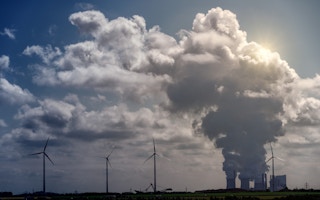Asia’s dependence on coal is completely at odds with the Paris Agreement to combat climate change, a UN official warned, as experts from the region met in Bangkok (2–6 September) to find ways to intensify efforts to stem global warming.
“Over 80 per cent of global coal power capacity under construction is in this region,” Kaveh Zahedi, deputy executive secretary of UN’s Economic and Social Council for Asia and the Pacific (ESCAP) said in a press briefing during the Asia-Pacific climate week conference on Wednesday.
China, India and the Southeast Asian region were leading in coal investments, he said, adding that 40 per cent of the region’s existing energy supply comes from coal.
“
Our region is still the one where the greatest new investments are being made in coal, and clearly that is incompatible with the ambitions of Paris.
Kaveh Zahedi, UN Economic and Social Council for Asia and the Pacific
Nations agreed in Paris in 2015 to keep the global average temperature increase to below two degrees Celsius and limit the rise to no more than 1.5 degrees. But the goals set by countries to curb their greenhouse gas (GhG) emissions have put the world on track for a three-degree Celsius rise by the end of the century.
According to Zahedi, while other regions are increasingly switching to greener sources of energy, Asian nations are still planning to rely on coal to meet a fast-growing demand for power.
China and India have significantly added solar and other renewable sources to their energy mix in recent years and developing countries like Indonesia and the Philippines are also starting to ramp up renewable energy and energy efficiency, but “clearly, it’s just not enough,” Zahedi said.
“Our region is still the one where the greatest new investments are being made in coal, and clearly that is incompatible with the ambitions of Paris,” he said.
Ovais Sarmad, deputy executive secretary of the United Nations Framework Convention on Climate Change (UNFCCC), said speeding up the transition to a clean energy future to curb climate change meant stopping the building of new coal-fired power plants by 2020 and removing billions of dollars in fossil fuel subsidies that discourage investments in renewables.
“Unfortunately, the current NDCs are not sufficient to keep within the targets of the Paris Agreement,” Sarmad said, referring to the goals called Nationally Determined Contributions (NDCs) that nations are currently designing.
Uptake of renewables is increasing in the Asia Pacific, and globally, as solar, wind and other technologies become cheaper. Additionally, the additional benefits of renewables such as improved health from reduced air pollution, and job opportunities in the clean energy sector were more widely understood, experts said at the conference.
“In many countries, renewables are the most cost-efficient option, the economics speak for themselves,” says Lea Renalder, project manager of REN21, an international policy network for sustainable energy.
Investment was also increasing at the national and community levels in green innovations such as battery storage, microgrids, floating solar panels and pay-as-you-go solar systems, some of which were increasing access to power in developing countries, Renalder tells SciDev.Net. Bangladesh, Fiji, Mongolia and Nepal have the highest rates globally of energy from off-grid solar systems, according to the World Bank.
You might also like
- ‘World Bank indirectly funding Asian coal projects’
- Powering up the ‘last mile’ in renewable energy rollout
- Murky climate deal lets down poor countries
- Hope and despair for Paris Accord goals at COP24
- ASEAN countries lag on renewable energy
- Renewables edging out coal in South-East Asia
- NGOs question World Bank’s fossil fuel pledge exemption
- Cities must lead the clean energy drive, says report
- India’s coal-fired thermal plants pose radiation hazard
- Power-sharing model can widen energy access in ASEAN
- Q&A: The risk of building new coal-fired plants
- Health assessment urged for new coal plants
In an interview with SciDev.Net at the sidelines of the conference, Christian Lohberger, president of the Solar Energy Association of Papua New Guinea, explains that given the drop in the price of solar energy in recent years, there is great potential in Fiji, Papua New Guinea and the smaller island nation states to leapfrog traditional energy sources and “go straight to the latest and greatest” renewables. However, comprehensive regulations and policies are needed in each country, including to attract foreign investment.
He points to the success in Papua New Guinea of small and light solar panels, which are replacing kerosene-based lanterns and firewood as sources of energy in remote, rural communities that lack connection to the power grid.
Over 800 officials from governments, civil society and the private sector took part in the week-long conference in Bangkok that ended Friday. Conferences are also being held in other regions to provide inputs to UN secretary-general Antonio Guterres ahead of COP25 in Chile in December.
This piece was produced by SciDev.Net’s Asia & Pacific desk.
This article was originally published on SciDev.Net. Read the original article.










